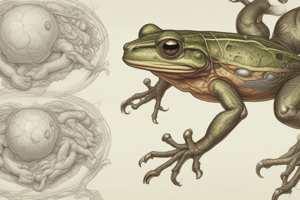Podcast
Questions and Answers
What is the primary source of food for larvae during the larval stage?
What is the primary source of food for larvae during the larval stage?
- Decaying organic matter
- Small fish and crustaceans
- Algae and small organisms (correct)
- Water plants and insects
Which of the following is NOT a physical change that occurs during toad metamorphosis?
Which of the following is NOT a physical change that occurs during toad metamorphosis?
- Changes in skin
- Development of limbs
- Development of lungs
- Development of a shell (correct)
Which hormone plays a key role in regulating the metamorphic process?
Which hormone plays a key role in regulating the metamorphic process?
- Growth hormone
- Insulin
- Adrenaline
- Triiodothyronine (T3) (correct)
What environmental factor affects the rate of metamorphosis?
What environmental factor affects the rate of metamorphosis?
What is the primary function of corticosteroids during metamorphosis?
What is the primary function of corticosteroids during metamorphosis?
Flashcards are hidden until you start studying
Study Notes
Toad Metamorphosis
Toad metamorphosis is the process by which a toad transforms from a larval stage to a adult stage. It involves a series of physical changes that allow the toad to adapt to its environment and develop its adult characteristics.
Stages of Metamorphosis
- Egg Stage: Toad eggs are laid in water and hatch into larvae.
- Larval Stage: The larval stage, also known as the tadpole stage, lasts several weeks to months. During this stage, the larvae feed on algae and small organisms.
- Metamorphic Stage: The larval stage begins to transform into a toadlet. This stage is characterized by the development of limbs, lungs, and other adult features.
Physical Changes
- Resorption of Gills: The gills are absorbed, and the toadlet develops lungs for air-breathing.
- Development of Limbs: The limbs develop, and the toadlet becomes able to move around on land.
- Changes in Skin: The skin becomes thicker and more resistant to water loss.
- Eye Transformation: The eyes move from the sides of the head to the top, and the eyelids develop.
Hormonal Regulation
- Thyroid Hormones: Thyroid hormones, such as triiodothyronine (T3), play a key role in regulating the metamorphic process.
- Corticosteroids: Corticosteroids, such as cortisol, help to regulate the stress response during metamorphosis.
Environmental Factors
- Temperature: Temperature affects the rate of metamorphosis, with higher temperatures speeding up the process.
- Water Quality: The quality of the water affects the development of the larvae and the success of metamorphosis.
Conclusion
Toad metamorphosis is a complex and highly regulated process that involves a series of physical changes and hormonal regulations. Understanding this process is important for conservation efforts and for appreciating the remarkable biology of toads.
Toad Metamorphosis
- Toad metamorphosis is the process by which a toad transforms from a larval stage to an adult stage, involving physical changes to adapt to its environment and develop adult characteristics.
Stages of Metamorphosis
- Toad eggs are laid in water and hatch into larvae.
- The larval stage, also known as the tadpole stage, lasts several weeks to months and involves feeding on algae and small organisms.
- The larval stage transforms into a toadlet during the metamorphic stage, characterized by the development of limbs, lungs, and other adult features.
Physical Changes
- Gills are absorbed, and the toadlet develops lungs for air-breathing.
- Limbs develop, and the toadlet becomes able to move around on land.
- The skin becomes thicker and more resistant to water loss.
- Eyes move from the sides of the head to the top, and eyelids develop.
Hormonal Regulation
- Thyroid hormones, such as triiodothyronine (T3), play a key role in regulating the metamorphic process.
- Corticosteroids, such as cortisol, help regulate the stress response during metamorphosis.
Environmental Factors
- Temperature affects the rate of metamorphosis, with higher temperatures speeding up the process.
- Water quality affects the development of the larvae and the success of metamorphosis.
Importance of Understanding Metamorphosis
- Understanding toad metamorphosis is important for conservation efforts and appreciating the remarkable biology of toads.
Studying That Suits You
Use AI to generate personalized quizzes and flashcards to suit your learning preferences.



